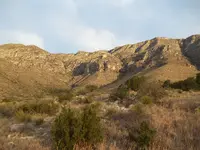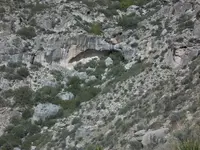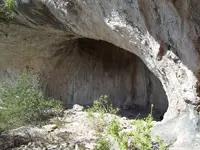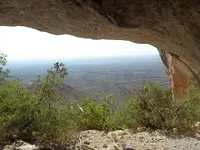Anyone still interested in this at all? No comments in a while, i am wanting to head to Guadalupe this spring for some "hiking"
Ben's story I believe happen in the late 1800's say 1870 +
Apache's were raiding through out the early 1800's...I wonder if this could be a cave where indians caches the loot
Here is a story just before Ben found whatever he found of indian attacks... and the gravestone is still there of Jose Maria Polancio
several written tales of indians attacking 158 years later, scout's death near Guadalupe Mountains still a mystery
While traveling Highway 62-180 to El Paso, many people are thinking about the beautiful scenery near the mountains and not about what might have taken place in the area in the mid 1800s.
A solitary gravesite remains under the watchful eye of El Capitan on private ranch land not far from the boundary of Guadalupe Mountains National Park. The occupant of this grave, shrouded by vegetation, is Jose Maria Polancio, an infantry guide for Capt. James Longstreet of the 8th Infantry.
The out-of-sight grave is in close proximity to the east side of the well-traveled highway as it transects Guadalupe Canyon.
Jose Maria Polancio s headstone (a little left of center) is a thin limestone oblong rock located in Guadalupe Canyon. His actual grave is surrounded by
Jose Maria Polancio s headstone (a little left of center) is a thin limestone oblong rock located in Guadalupe Canyon. His actual grave is surrounded by smaller rocks. As seen in the photo, the grave is in relatively close proximity to El Capitan in the Guadalupe Mountains. (Photos by Valerie Cranston Current-Argus)
Following the end of the Mexican-American War and recovery from a wound, Longstreet served in frontier duty in Texas, performing scouting missions. First at Ft. Martin Scott near Fredericksburg and then Fort Bliss in El Paso.
Polancio was killed by the native people in February 1855. Not much is known about his life before he became an infantry guide, but rumor has it he was of Mexican and Apache descent.
It wasn't the circumstances surrounding his death that were so unusual. What was intriguing were the events that followed. He was found dead with seven arrows in his naked body by one of the infantry men. His body was later found again after being dug up, scalped, stripped of clothing and shot with arrows again.
Following Polancio's death, Longstreet wrote a lengthy letter to the colonel in command dated Feb. 17, 1855, explaining the fate of his guide. The letter was sent to the Department of New Mexico. The contents of the letter are summarized and quoted below.
Jan. 24, 1855
"My orders were to operate between the Hueco Tanks and the Guadalupe Mountains and cooperate, if occasion offered, with Capt. Ewell or Major Simonson, or both," wrote Longstreet.
Jose Maria Polancio was a guide for Capt. James Longstreet of the 8th Infantry in 1855. He was of Mexican and Apache descent. The inscription on the
Jose Maria Polancio was a guide for Capt. James Longstreet of the 8th Infantry in 1855. He was of Mexican and Apache descent. The inscription on the headstone reads: Jose Maria Polancio Guide Killed Feb. 1855 By Indians.
"On the 24th ult. (month prior) I marched with Companies I & K of this post, total strength 54, including one musician, Capt. Holloway and Lt. Follett," he wrote, noting Holloway and Follett were also officers of the command.
Jan. 25, 1855
Wagons pulled by teams of mules were heavily loaded down. After traveling two hours on bad roads, Longstreet met Polancio for the first time.
Jan. 26, 1855
On the morning of the 26th, Polancio and two non-commissioned officers mounted horses and rode ahead as an advance party.
Jan. 27-28, 1855
Longstreet had to repair places in the road so his mules could pull the wagons. His mules began to fail that day and again the next day.
Jan. 29, 1855
During the afternoon of the 29th, he discovered smoke in the direction of the Guadalupe Mountains or beyond. Late afternoon one of the officers in the advance party came back and reported a large trail met and followed the road.
"It appeared to be the trail of about 40 cattle driven by eight or 10 Indians," Longstreet wrote, adding the guide told him he thought the party was at the water source ahead of them.
"I made arrangements for attacking them at once; and with the hope of surprising them I marched down to the water by moonlight, leaving wagons behind," he wrote, noting his disappointment that the Indians had gone in the direction of the mountains.
Polancio still thought the Indians were only a few miles away. Longstreet ordered Lt. Follett and 12 non-commissioned officers and men, along with Polancio, to follow the trail to find out at first light the whereabouts of the Indians. Longstreet did not want them to attack, if at all possible, until he could join them.
About 10 p.m. that night, Longstreet received word that the patrol had followed the Indians' trail into the mountains about 6 miles from the water source. Longstreet sent food and water along with orders. Again, he wanted the men to stay put until he joined them.
Jan. 30, 1955
Longstreet began the task of preparing rations for six days and filling canteens with water. He left camp in the middle of the night hoping to reach the mountains by first light.
"We found, of course, that the Indians had taken the roughest parts of the mountains, frequently crossing them where footmen could scarcely climb," Longstreet wrote.
By nightfall the men were out of water. Longstreet wanted to march by moonlight in search of water, however, the men were exhausted. They rested in a pinery on top of one of the highest mountains in the range.
"I called up the guide and asked him the prospects of getting water on the trail," he wrote. "He said that I might find it in 24 miles but that he was not certain that I would.
"I at once determined to turn back at daylight in the morning and sent my mounted men back at once to have water sent out in the canteens to meet us," he wrote, adding his intention was to move around the mountains and take up the Indians' trail in hopes of finding the cattle.
Jan. 31, 1855
Not long after leaving camp, Longstreet and the men came to a deep, sandy area. In a short time the mules tired, giving completely out. He had to use other mules to haul the wagon back to camp, traveling only 12 miles that day.
Feb. 1, 1855
This day was a repeat of the day before. Mules tiring, giving out and other mules sent back for the wagons. They traveled only 9 miles this day. Camp was set up at the first spring in the Guadalupe Mountains.
"Here I abandoned all hope of being able to reach the trail at all and resolved to wait for Capt. Ewell or Major Simonson," Longstreet wrote.
Polancio went missing that afternoon and some of the men thought the Indians had killed him. Others just thought he left and returned home.
"I had given him a scolding the day before for leaving the two mounted men and the men who were with him," Longstreet wrote, adding he supposed he frightened Polancio and he had run off.
Feb. 2-4, 1855
The morning of Feb. 2, Longstreet ordered a sergeant and six men to track the guide's trail and see if they could determine what really happened to him. The sergeant later reported he found his tracks and it appeared Polancio had turned at the point of the mountain and come in.
Late afternoon, one of the men came to Longstreet's tent and reported that the naked body of Polancio was lying on the mountain side near the spring.
"Lt. Follett and I went up and found the dead body stripped and pierced with seven arrow wounds. I had it taken to camp and buried," Longstreet wrote. "We could arrive at no satisfactory conclusion as to how the Indians got upon him. They must have ambushed him, I supposed."
Feb. 5, 1855
This day Longstreet sent out a party of men to look for a more suitable place to camp. Wood was scarce at the present camp. That afternoon the men returned reporting they had found a spring, plenty of timber and grass some 7 miles ahead.
Feb. 6-8, 1855
Longstreet moved his company to the area with a spring and plenty of timber.
Feb. 9-10, 1855
Major Simonson and his party rode into Longstreet's camp. He immediately shared with Simonson all of the Indian news he had.
"A party of his that came through my old camp reported that the Indians had been to my camp after I left it and taken up the body of the guide, scalped it and robbed it of the buffalo robe that was around it and shot fresh arrows into it," wrote Longstreet. "I urged the major to take up and follow the trail that I had been obliged to abandon.
"I assured him that there was scarcely a doubt but he would be able to overtake and punish the Indians," he wrote.
Longstreet tried to get Simonson and his party to follow the Indians' trail into the mountains where he was sure they all were holed up. He offered rations and water. Simonson, at first, expressed a willingness to cooperate, however, in the end he decided he would rather go to Delaware Creek if he did not cross another trail before arriving there.
"So I reloaded my wagons, took my leave of the Major and took up the march for my post," he wrote.
"I am, Sir, very respectfully, Your Most Obt. Servant. James Longstreet. Capt. 8th Inf. 3t. Major," Longstreet wrote, signing off on his letter to the colonel at the post.
The thin limestone marker at the head of Polancio's grave in Guadalupe Canyon reads: "Jose Maria Polancio -- Guide -- Killed Feb. -- 1855 -- By Indians."
....their bodies are buried in the dust, but their names shall live to renew...
I wonder what was Subletts job, what did he do in the spare time? Was there an army post in the area he was living? How friendly was he with the banker? how was he friendly with the indians or was he just really sneaky...?







